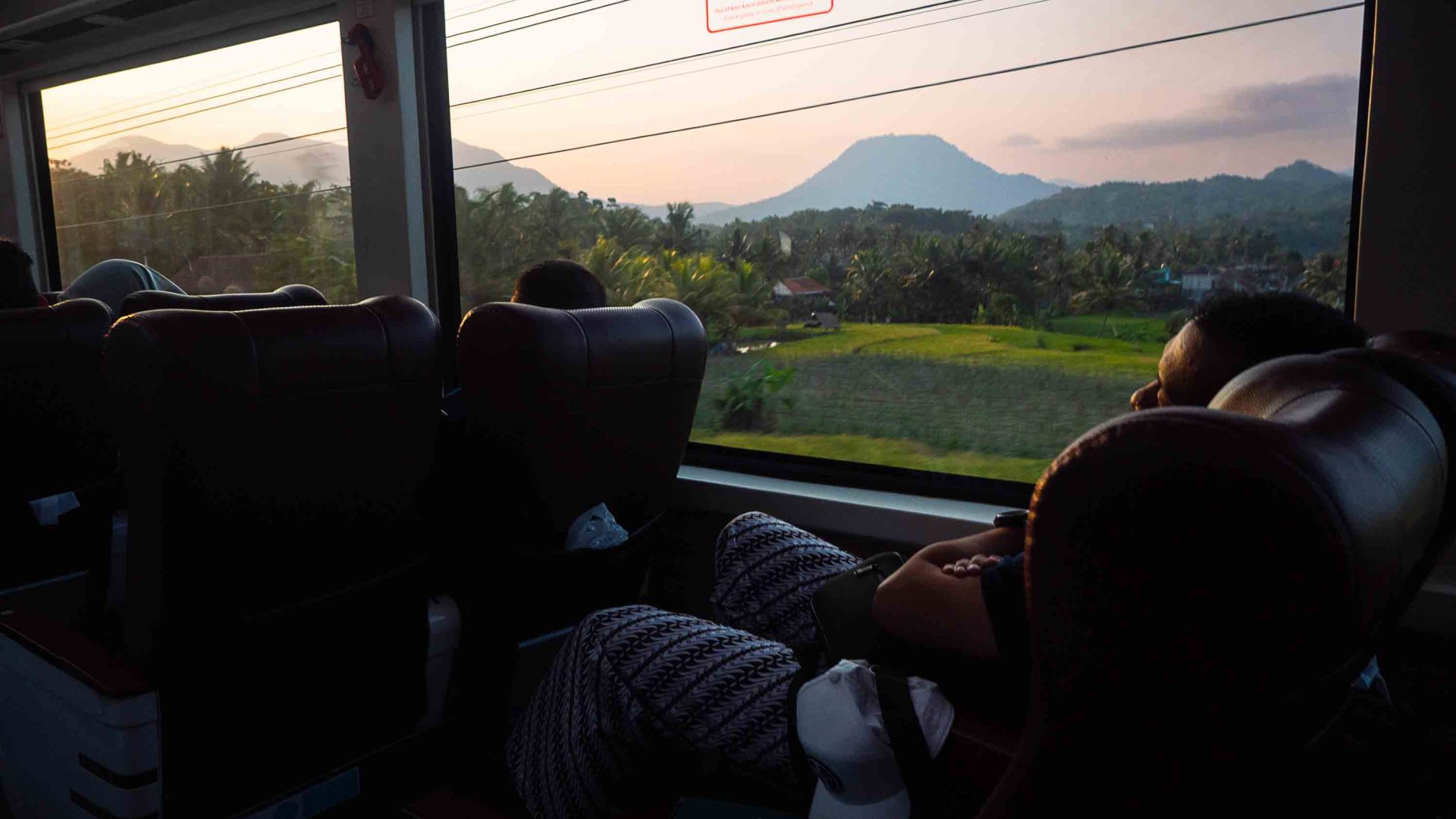
While Bali has become Indonesia’s best-known destination, there’s far more to explore. Leaving her home island of Lombok, writer Leyla Rose heads west and takes the slow train through Java, the world’s most populated island.


While Bali has become Indonesia’s best-known destination, there’s far more to explore. Leaving her home island of Lombok, writer Leyla Rose heads west and takes the slow train through Java, the world’s most populated island.
“Selamat jalan!” The perky ticket attendant wishes me a safe journey as I scan my digital ticket. I drag my suitcase across the tracks and position myself on platform five of Surabaya Gubeng station, a sense of giddiness rising up amid the echoes of station announcements and babble of commuters.
For two weeks, I’ll be riding Java’s extensive railway network 782 kilometers from East Java towards the capital Jakarta on the northwest coast, stopping off to learn more about the history of my country, eat ridiculously good food, and chat with local people.
Surabaya seems a fitting place to start: It’s here on November 10th 1945 that the most bloody conflict, the Battle of Surabaya, of Indonesia’s war of independence took place as the newly-declared nation looked to break free from the shackles of 350 years of Dutch colonial rule. It’s on the streets of this city that the people of Indonesia rallied and the spirit of independence was galvanized.
While the island nation of Indonesia is home to 275 million people, over half of that population live in Java. One of the most densely populated islands on earth, Java is a place of fascinating contrast—home to some of Indonesia’s largest cities, but also active volcanoes, long rivers and lush rainforests. Due to its sprawling population, Java has one of the best rail networks in Southeast Asia (in no small part down to the Dutch colonialists’ need for good transport). Planes, buses and boats abound too, but trains are king.
I first took the train from Surabaya to Yogyakarta as a teenager on a school trip. I don’t remember much, bar the onboard menu and reversible seats.
Today, I clamber aboard the special panoramic carriage of the executive class Argo Wilis, which operates a scenic journey between Bandung and Surabaya. Each train has a wonderful name named after volcanoes or local folklore; this one after a mountain in East Java. The morning light pours in through skylights and large windows, my seat is comfortable, reclinable, with a foot rest, and plenty of legroom… It’s not hard to settle into this four-hour journey to my first stop, Yogyakarta.
If learning about the culture and heritage of Indonesia is on your list, I’d go as far as to say skip Bali and head straight to Yogja.
As we glide out of Surabaya, we’re impeccably on time; a strange concept for this archipelago that’s known for its laidback ‘island time’ approach. The trains are affordable too; a single fare between Surabaya and Yogyakarta cost me IDR (Indonesian rupiah) 700,000 (USD$45) for a journey of around 310 kilometers. Having spent last Christmas traveling the length and breadth of the UK by train, it’s hard not to draw comparisons between this and the poor state of the UK rail network today.
What’s more, they’re feeding me too. Friendly staff take hot drinks orders, before handing us snack boxes filled with popcorn, doughnuts and other pastries. In a way, I’m not surprised. Food is an integral part of Indonesian society, binding the nation together… ”Have you eaten yet?” is a common greeting, and social gatherings revolve around food. And it’s not potato chips and cheese sandwiches: There are rice dishes, various iterations of noodles, fried chicken and desserts for around IDR30,000 (USD$2). It’s delicious, and tastes like real home cooking, the best type of Indonesian food.
I relax into my seat, watching the city transition into villages, the steady rhythm of train wheels beneath me. Houses are built right up to the edge of the tracks, offering a glimpse into everyday life.
A lady hangs out the laundry, a baby hanging off her hip. In a dusty courtyard, an old man fixes an ancient bicycle. Soon enough, the villages disappear and we’re chugging at a steady speed through the countryside. Lush, green rice paddies criss-cross into the distance, its nutrient-rich soil thanks to the distant volcanoes on the horizon.
A mother and her six-year-old are sitting a couple of rows ahead of me. They’re visiting her parents in Solo, a city in central Java. “Trains are the best way to travel around Java,” she tells me. “They’re much more affordable and easier than flights.” Living in Lombok where there’s no train in sight, I’m a little jealous.
Lunchtime rolls around and we’re each handed a lunchbox with rice, stir-fried vegetables, chicken curry, fried tofu, and corn fritters. After a few hours, the Argo Wilis slows down as it approaches Yogyakarta Station. Also known as Yogya or Jogja, this central Javan city—in the region of the same name—is Indonesia’s cultural heart, a longstanding arts and culture hub, encompassing everything from traditional dance and shadow puppetry, to silversmithing and batik textiles.
If learning about the culture and heritage of Indonesia is on your list, I’d go as far as to say skip Bali and head straight to Yogya. Walking along Yogya’s bustling Malioboro Street, I’m surprised to see as many foreign tourists as I do, and feel pleased the city is getting the recognition it deserves.
Yogyakarta is unique in many ways. For one thing, it’s the only region in Indonesia that still has a ruling monarchy. The Sultanate of Yogyakarta was established in 1755, becoming a protectorate of the Dutch East India Company while maintaining a high degree of autonomy under Dutch colonial rule until 1942. After Japanese occupation during World War II, Yogyakarta played a crucial role in Indonesia’s struggle for independence, formally becoming part of the republic in 1950, though you’ll still find colonial-era buildings in the city.
As we climb into the highlands, the sun sinks lower, a golden light illuminating the landscape. The train snakes around tight bends, rushing out across bridges over plunging gorges before ploughing back into the forest. This is one of the most beautiful train journeys on earth.
You see this fusion at the Kraton, the royal palace. In this sprawling complex of courtyards, grand pavilions and magnificent hallways, traditional Javanese architecture blends with Dutch-influenced flourishes and stained glass. You can also hear gamelan—traditional Javanese percussion music—or enjoy classical dance, puppetry and poetry, included in the ticket.
Everyone I speak to, from the young, softly-spoken traditional dancer to the elder Abdi Dalem, one of the king’s guards, the message is the same. “It’s vital that we look after the culture of our ancestors,” says Atmoharjo, one of 2,487 Abdi Dalem working at the palace. Dressed in his royal-blue shirt with batik sarong and headdress, he looks magnificent.
Yogya is also a hub for batik production, the fabric design made by wax-resist dyeing—batik is such an important part of Indonesian culture it’s been recognized by UNESCO as an Intangible Cultural Heritage. I join a workshop at the Museum of Batik where prices start at IDR90,000, approximately USD$6, per person. You can choose how many colors you want to work with—the more you do, the longer it takes.
After choosing a motif of a peacock, tutor Ibu Wagiyem shows me how to fill a spouted tool with hot wax and effortlessly trace the pattern. She’s been doing this for over 20 years and makes it look easy. If she’s unimpressed by my laughable attempt, she doesn’t let it show.
She tells me how each region in Java has its own design and meaning. “In areas like Cirebon on the north coast of Java, the batik has more vibrant colors,” she explains. “Trading ships stopped there, so different dyes and inks were available to them. Places inland such as Yogya and Solo are limited to earth colors, so the batik of each region really reflects the environment.”
Yogya is also a base for anyone who wants to visit the temples of Borobudur and Prambanan. About an hour’s drive out of the city in opposite directions are these two breathtaking UNESCO World Heritage Sites dating back to the 9th century.
Borobudur is the largest Buddhist temple in the world and a popular sunrise trek; the light over the vast complex is unforgettable. Meanwhile, Prambanan, Indonesia’s largest Hindu temple, is quite the sight at sunset especially if you can catch the Ramayana Ballet (ask in Yogya for updated schedules) at the nearby outdoor theater. Set against the dramatic backdrop of the temple, watching this epic Hindu saga of good over evil, performed through Javanese dance alongside gamelan music turns out to be the most memorable moment of my trip.
Back at Yogyakarta station, there’s a lively surge of holidaymakers, families hugging goodbye, and taxi drivers offering rides. I’m back aboard the Argo Wilis for a six-and-a-half hour journey to my next stop: Bandung.
The views from the first leg of the trip soon pale in comparison to what I see now. Groves of coconut trees sway in the breeze, rivers meander lazily, and terraced rice fields dart past in a flash of green. The views, steady rhythm and forward momentum give me time to contemplate too. I think about how different Java is to my home island of Lombok, and yet so similar. The landscape looks familiar—we have rice terraces and palm trees too—but the people speak a different language (variations of Javanese, as opposed to Sasak), dress less conservatively and eat less spicy food. It’s a reminder of Indonesia’s vastness and diversity.
We squeal to a halt at a small, sleepy station, snapping me out of my daydream. An excited gaggle of kids watches us from the roadside. When I wave, they break out into fits of laughter and wave back. We then climb into the highlands, the sun sinks lower and a golden light illuminates the landscape. The train snakes around tight bends, rushing out across bridges over plunging gorges before ploughing back into the forest. This is one of the most beautiful train journeys on earth.
Everything in Bandung is a pleasant surprise, including the station. Yogyakarta’s is more old-school, Bandung’s is modern and bright. Alongside colonial buildings from Dutch rule, Art Deco buildings are occupied by hip coffee shops and clothes stores, and mature trees line the shaded streets, living up to its nickname, ‘the Paris of Java’.
PQ: The slow train from Bandung takes around three hours, but since October 2023, this journey has been cut down to just 30 minutes with the arrival of the Whoosh, Indonesia’s first high-speed railway.
At 768 meters above sea level, Bandung has a much cooler climate than other cities in Java, with temperatures from 17 to 29 degrees Celsius. It’s no wonder the Dutch were so keen to relocate their colonial capital here, away from the oppressive heat of Jakarta. A 15-minute drive away is a vast forest park with trails and caves that dive deep into the hills surrounding the urban sprawl. Drive a little further, and you’ll find the smoking, sulphuric volcano of Tangkuban Perahu, and the picturesque tea plantations of Ciater.
Bandung also has a reputation for excellent food, and I’ve come armed with a list. Taking tips from the locals too, I fill my boots, trying smoky grilled satay from a roadside stall, thick and rich lomie noodle broth, and traditional Sundanese (the ethnic group indigenous to this region of West Java) dishes at Dumuk Bareto, a serve-yourself-style restaurant. Not a single dish disappoints. I’m quickly falling for Bandung. Chatting to a friend who lives here, I learn more about what makes it so unique.
“Jakarta is the centre for finance and tech, but Bandung is the place for creatives and start-ups,” says Yudi, a local business owner and keen cyclist. “All the nature around us contributes to the slower pace of life and I think people have more time to relax and indulge. I think that’s why the food and coffee culture here is such a big thing.”
I’m sad to leave Bandung—and its restaurants—behind, but the capital is calling. Home to almost 34 million people, this mega-metropolis is almost unfathomable in size, and the largest in Southeast Asia.
The slow train from Bandung takes around three hours, but since October 2023, this journey has been cut down to just 30 minutes with the arrival of the Whoosh, Indonesia’s first high-speed railway. It’s the first in Southeast Asia—and the southern hemisphere—and a big deal for Indonesia, a reflection of its status as a rising power and one of Asia’s fastest growing economies.
Java is modernizing rapidly and nothing encapsulates that more than flying across land at 350km/h. It’s my first time on a high-speed train, and I feel like a kid again. Everything is new and glossy, and the batik-patterned seats are plush and comfortable; so much so, I wish the journey was still three hours. We whizz past villages and countryside, abruptly interrupted for seconds by pitch-black tunnels—kereta api, the Indonesian word for ‘train’, translates to ‘fire carriage’. It’s never been more apt.
All too quickly, we arrive at Jakarta’s Halim Station. Jumping on the LRT (Light Rapid Transit), we glide between the streets under a famously yellow-gray sky, watching the skyscrapers above choked by pollution from the crawling traffic below. This city is notoriously sinking, figuratively under a mass of people and cars, and quite literally too. A combination of climate change, poor urban planning, groundwater extraction and its position on a delta mean that parts of the city are sinking up to 11 inches a year. The heat and humidity is oppressive, and I soon understand why most people flutter from one air-conditioned mall to another.
Fortunately, in recognition of this relentless pollution and chaos, the city has implemented a Car-Free Day policy in certain parts. Every Sunday morning between 6am and 11am, the engines fall silent and the fumes dissipate. I join thousands of people walking, running and cycling as they reclaim the streets. It’s a poignant moment, a glimpse of what Jakarta could be with better planning and infrastructure. However, our government has opted for a different, rather eyebrow-raising approach—by moving the entire capital.
Throughout the journey, I’ve seen red-and-white national flags hung from buildings, decorating hotels, restaurants, shops and vehicles, in anticipation of Independence Day on August 17. On the day, I join the crowds at Merdeka Palace, one of the presidential palaces, but Indonesia’s outgoing president, Joko Widodo, is nowhere to be seen. He’s currently in Nusantara, the controversial new capital undergoing construction from scratch hundreds of miles away on the island of Borneo.
This brash, bold move to build a brand new capital from scratch is indicative of Indonesia’s forward momentum in the 21st century, and sums up my time in Java. The old culture and traditions are upheld and respected, finely balanced, but juxtaposed with rapid modernization as seen from the new high-speed railway.
At the end of the line, I found myself surprised by just how much I enjoyed this trip. I have always headed abroad to experience new cultures, traditions, language and cuisine, but I’d realized I can find all that right here in Indonesia—in some ways, it was like going to another country, such is the sprawling variety of Java. Transitioning from one city to the next, I noticed differences between each—sometimes major, sometimes subtle—and passing through one after another, slowly, by train, was the perfect way to do that.
****
Adventure.com strives to be a low-emissions travel publication. We are powered by, but editorially independent of, Intrepid Travel, the world’s largest travel B Corp, who help ensure Adventure.com maintains high standards of sustainability in our work and activities. You can visit our sustainability page or read our Contributor Impact Guidelines for more information.






Can't find what you're looking for? Try using these tags: